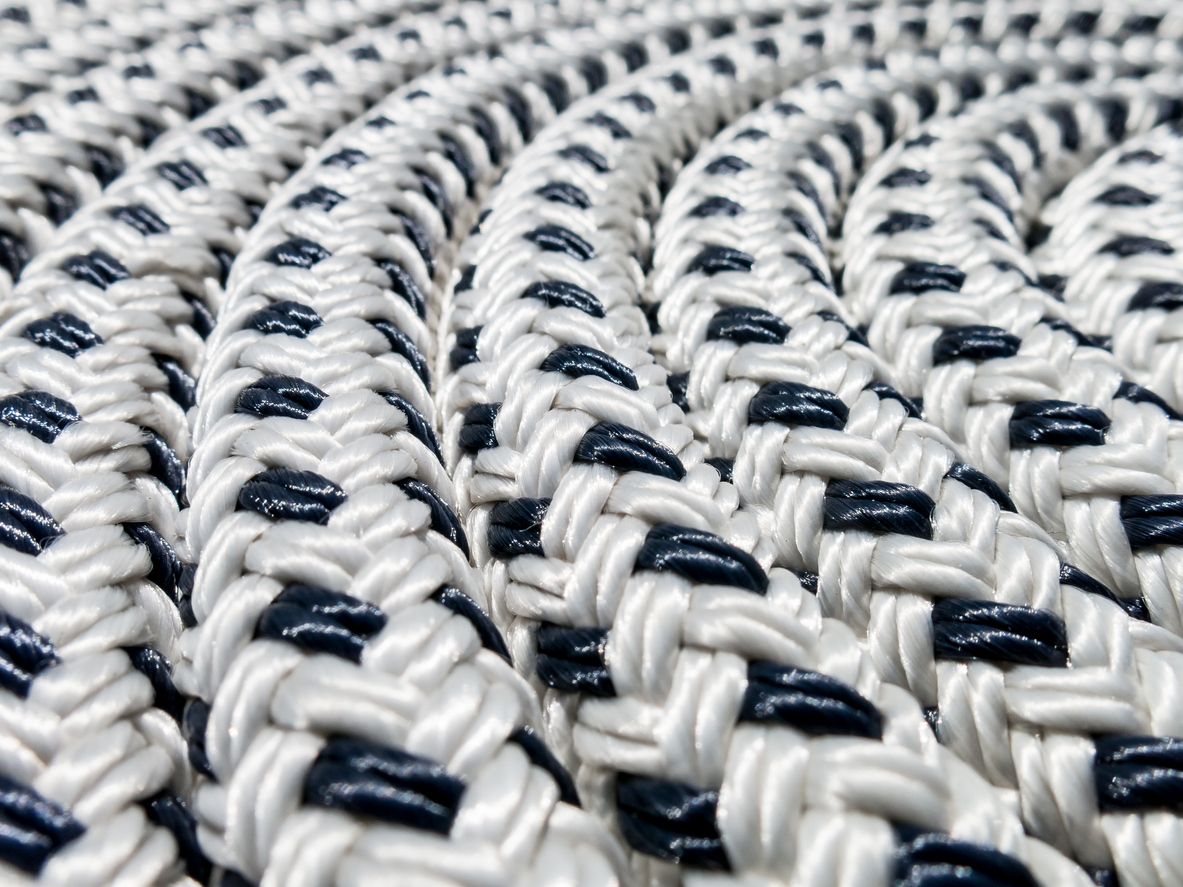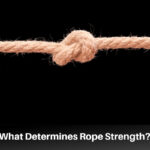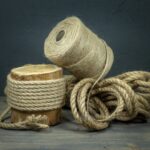Polyester rope is a strong synthetic type of rope ideal for marine applications. It is almost as strong as nylon in normal conditions and stronger when wet. It is resistant to most environmental factors that normally break down ropes, so it’s ideal for everyday outdoor use.
Polyester was discovered around the same time as nylon. Researchers set aside their studies on polyester because nylon was deemed more important for fabrics and the war effort. It wasn’t until decades later that polyester became a popular material for rope-making.

One of the strongest rope materials, polyester retains its strength when wet. Consult the chart below to see the tensile and breaking strength of polyester rope.
Due to its durability, polyester rope has several uses, including:
- Boating & marine applications
- Crochet
- Macrame
- Hammocks
Follow the steps below to learn how to cut polyester rope to prevent fraying.
Consult our simple chart below to see polyester rope’s advantages and disadvantages.
Check out the more in-depth chart below to see how polyester rope compares with other synthetic rope materials.
What Is Polyester Rope?
Polyester rope goes by many names, including Dacron, Terylene, and Trevira.
Polyester rope is one of the strongest ropes available and is popular for use around water. One of the best features of polyester rope is that it doesn’t lose its strength when wet.
It is resistant to moisture, chemicals, UV light, and abrasions. It has a high melting point of 464°F (240°C). It is not electrically conductive.
Polyester is resistant to most alkalis and acid chemicals kept at room temperature. As the chemicals increase in temperature, the resistance of the rope decreases. It is also resistant to solvents, bleaches, and petroleum-based products.
The fibers are incredibly durable and resistant to outdoor wear and tear. After two years of consistent outdoor use, most polyester ropes will only lose about 10% of their original breaking strength.
Polyester fibers are white and thin, generally only about 0.023 mm in diameter. Their delicate quality and white color resemble hair.
Polyester rope is easy to splice with nylon, stainless steel, soft eyes, or galvanized thimbles.
Does Polyester Rope Float?
No, polyester rope does not float.
Does Polyester Rope Stretch?
Polyester rope is almost as strong as nylon but doesn’t absorb shock as well because it has little stretch. Despite not being stretchy, it is flexible and easy on the hands.
Is Polyester Rope UV Resistant?
Polyester rope is one of the most UV-resistant ropes, superior even to nylon.
The History Of Polyester Rope
Researcher, Wallace Carothers, was working for DuPont, researching synthetic fibers and large molecules. He discovered polyester but set his research aside in favor of his research on nylon, one of the first synthetic fibers created.
Although Carothers discovered polyester, his research was incomplete. So, the British company, International General Electrical, was the first to patent polyester in 1928. The British scientists, Dickson and Whinfield, picked up Carothers’ work. They patented polyethylene terephthalate (PET) in 1941. PET is the basis of polyester and similar materials. Then, DuPont bought the legal rights from Imperial Chemical Industries (ICI) in 1946.
Polyester was most popular for use in fabric. It wasn’t commonly used for rope-making until the 1950s, when the materials became cheaper and more widely produced.
How Strong Is Polyester Rope?
Polyester rope is one of the strongest ropes available. To know precisely how strong it is, users first need to understand the difference between tensile and breaking strength.
Tensile and breaking strength both refer to the amount of load a rope can take before breaking. The tensile strength is measured in controlled laboratory conditions. The breaking strength considers how the rope will be used in the real world. It considers environmental stressors, knots, and other factors likely to weaken the rope.
So, the breaking strength is more accurate than the tensile strength when determining how strong a rope is.
The strength of a polyester rope also depends on its construction. Ropes with thicker diameters can take heavier loads.
Double-braided polyester rope is the strongest, followed closely by solid-braided polyester rope. Plaited rope is the third strongest, and twisted rope is the weakest.
* Use caution and work well below the breaking strength of a rope. The breaking strength is just an estimate. The actual breaking strength of each rope may be higher or lower than the estimate. Avoid injury by working below the breaking strength. *
Consult the chart below for the estimated breaking strength of polyester ropes.
Breaking Strength Of Polyester Rope (In Pounds)
| Diameter (inches) | Tensile Strength (Solid Braid) | Breaking Strength (Solid Braid) | Tensile Strength (Double Braid) | Breaking Strength (Double Braid) | Tensile Strength (3-Strand Twisted) | Breaking Strength (3-Strand Twisted) | Tensile Strength (12-Strand Plait) | Breaking Strength (12-Strand Plait) |
| ⅛ | 355 | 71 | — | — | — | — | — | — |
| 3/16 | 626 | 125 | — | — | — | — | — | — |
| ¼ | 1,000 | 200 | 2,000 | 400 | 1,650 | 825 | 2,100 | 420 |
| 5/16 | 1,600 | 320 | — | — | — | — | — | — |
| ⅜ | 2,300 | 460 | 4,400 | 880 | 3,700 | 1,850 | 4,600 | 920 |
| ½ | 3,000 | 600 | 8,200 | 1,640 | 6,400 | 3,200 | 8,000 | 1,600 |
| ⅝ | — | — | 14,000 | 2,800 | 10,000 | 5,000 | 12,100 | 2,420 |
| ¾ | — | — | 20,000 | 4,000 | 12,500 | 6,250 | 15,800 | 3,160 |
| ⅞ | — | — | 29,900 | 5,980 | 18,000 | 9,000 | 24,200 | 4,840 |
| 1 | — | — | 38,000 | 7,600 | 22,000 | 11,000 | 27,500 | 5,500 |
| 1-¼ | — | — | 54,500 | 10,900 | 33,200 | 16,600 | 42,100 | 8,420 |
| 1-½ | — | — | 72,000 | 14,400 | 46,800 | 23,400 | 59,600 | 11,920 |
| 1-⅝ | — | — | 77,800 | 15,560 | — | — | 72,200 | 14,440 |
| 1-¾ | — | — | 89,200 | 17,840 | — | — | 84,400 | 16,880 |
| 2 | — | — | 110,000 | 22,000 | — | — | 101,000 | 20,200 |
| 2-¼ | — | — | 141,000 | 28,200 | — | — | 137,000 | 27,400 |
| 2-½ | — | — | 170,000 | 34,000 | — | — | 163,000 | 32,600 |
| 2-⅝ | — | — | 186,000 | 37,200 | — | — | 179,000 | 35,800 |
| 2-¾ | — | — | 206,000 | 41,200 | — | — | 202,000 | 40,400 |
| 3 | — | — | 237,000 | 47,400 | — | — | 233,000 | 46,600 |
| 3-¼ | — | — | 292,000 | 58,400 | — | — | 282,000 | 56,400 |
| 3-⅝ | — | — | 348,000 | 69,600 | — | — | 340,000 | 68,000 |
Cutting Polyester Rope
It’s crucial to cut synthetic rope in a way that won’t cause fraying. It’s not hard to do by following the simple steps below:
[1] Prepare the supplies.
A sharp knife works best for cutting; avoid scissors as they cause fraying. For ropes with thicker diameters, a pair of loppers or a hot knife may be necessary.
Electrical tape or a lighter will also be essential to seal the rope around the cut. Without one of these items, the rope will likely fray.
[2] Choose where to cut.
Look over the rope and choose a spot without any damage or fraying. Cutting a frayed or damaged rope will only cause more fraying.
[3] Tape the rope (Skip to step 4 when using a hot knife instead of tape.
To protect the rope and prevent fraying, wrap electrical tape around the area to be cut. Wrap the rope three to four times, making the tape as tight as possible. The layers should not sit right overtop of one another. Rather, they should slightly overlap.
* Duct tape or masking tape also works well in the absence of electrical tape. *
[4] Cut the rope.
The cutter should hold the rope with their non-dominant hand. They should hold the knife with their dominant hand. Cut the rope in the center of the tape.
A hot knife works well for cutting when there is no tape available. A hot knife cuts and melts the rope to prevent fraying.
* Note that hot knives are only useful for polyester and other synthetic materials. A hot knife cannot be used on natural rope materials. *
[5] Seal the rope.
The electrical tape makes an effective seal, so further sealing isn’t necessary when that’s used. Yet, a lighter will be necessary to seal a rope cut with only a hot knife.
Using a lighter, melt the ends of the rope around the cut. Doing so prevents fraying or unraveling.
[6] The rope is now cut and ready to use.
The Uses Of Polyester Rope
Polyester rope is strong and durable. So, it has many uses for crafters, outdoor adventurers, and jobs.
Polyester Rope For Crochet
It’s not as common as using yarn, but some crafters use polyester rope to make their crochet creations. Thin polyester rope is useful for longer-lasting outdoor decorations. Some things crocheters make with polyester include:
- Cushions
- Baskets
- Curtains
- Handbags
- Backpacks
- Other decor
Polyester Rope For Macrame
Just like crochet, polyester rope is useful for macrame crafting. Polyester rope is more common with macrame. Unlike crochet, macrame relies on rope materials rather than yarn for its creations.
Polyester macrame creations include things like:
- Hanging shelves
- Flower pot holders
- Wall hanging decorations
- Rugs
- Baskets
Polyester Rope Hammock
Polyester rope is a popular material for hammocks because it holds up well when left out in the elements. It’s also comfortable to lay in, and the ropes come in various colors.
Polyester Rope For Boating & Marine Applications
Polyester is one of the most popular ropes for use in boating. Its popularity is due to its strength and resistance to water.
Some of the most common uses of polyester rope on boats include:
- Mooring
- Rigging
- Fish nets
- Bolt rope
- Rope slings
- Use with towing hawsers
- Anchor lines
- Fender lines
- Lanyards
- Winches
- Capstans
- Black and tackles
Other Uses Of Polyester Rope
- Industrial plants
- General household use
Advantages And Disadvantages Of Polyester Rope
Easily consider the pros and cons of using polyester rope by consulting this chart:
The Pros & Cons Of Using Polyester Rope
| PROS | CONS |
| Strong UV-resistant Moisture-resistant Chemical-resistant Abrasion-resistant Easy to splice Flexible & soft Does not lose strength when wet | Little Stretch (Does not absorb shock loads well)Does not float Not eco-friendly |
How Does Polyester Rope Compare To Other Synthetic Ropes?
Consult this chart to compare the qualities of polyester rope to other synthetic ropes:
Comparison Of Synthetic Ropes
| Polyamide (Nylon) | Polyester | Polyethylene | Polypropylene | |
| Abrasion Resistance | Great | Great | Fair | Fair |
| Acid Resistance | Good | Great | Great | Great |
| Alkali Resistance | Great | Great | Great | Great |
| Buoyancy | Sinks | Sinks | Slightly Floats | Floats |
| Durability | Great | Great | Fair | Good |
| Handling | Great | Great | Good | Good |
| Strength | Great | Good | Good | Fair |
| Melting Point | About 250°C (484°F) | About 245°C (473°F) | About 128°C (262°F) | About 150°C (302°F) |
| Rot & Mildew Resistance | Great | Great | Great | Great |
| Shock Loading | Great | Fair | Poor | Good |
| Storage | Wet or Dry | Wet or Dry | Wet or Dry | Wet or Dry |
| U.V. Resistance | Fair | Great | Fair | Poor |
FAQs
What Is The Difference Between Polyester And Polypropylene Rope?
Polyester and polypropylene are both synthetic materials comprising plastic. Yet, their composition is slightly different.
Polyester derives from petroleum. It is more common than polypropylene because it’s more versatile. Polypropylene is a resin that is created through the polymerization of propylene.
Generally, polyester is a better choice for most applications. It’s more durable than polypropylene. Polyester is more abrasion and UV-resistant. It also has a higher melting point and is stronger.
Polypropylene is superior in some circumstances. Unlike polyester, polypropylene floats, so it’s suitable for use around water. It also has a better shock-loading capacity than polyester.
Is Polyester Rope Better Than Nylon Rope?
Polyester rope tends to be better for marine applications. Nylon is better for industrial applications, farm use, and rock climbing.
Nylon is generally stronger than polyester rope, except when wet. Polyester rope maintains its strength when wet. Nylon rope loses much of its strength when wet. So, polyester is much more common in marine applications than nylon.
Nylon has a slightly higher melting point than polyester and better shock-loading capabilities. Polyester has higher UV resistance than nylon.
Where Can You Buy Polyester Rope?
Polyester rope is very common, especially in marine applications. So, customers can buy it anywhere rope is available online or in person.
Some stores that sell polyester rope include:
- Home Depot
- Lowe’s
- Walmart
- Michael’s
- Tractor Supply Co.
- Amazon
- ULINE
Is Polyester Rope Safe For Pets?
Most experts agree that ropes, natural or synthetic, are best avoided when it comes to pets. Ropes can cause impactions and digestive issues in pets who swallow them. Even under direct supervision, it’s difficult to prevent a pet from swallowing a piece of rope.
Vets generally suggest avoiding toy ropes for dogs who love to chew and swallow items they shouldn’t. Likewise, rope and yarn are usually not good for cats or birds.
Some natural ropes, like sisal, can be safe for cat scratching posts and rope perches for small birds. Larger birds and small birds that are excessive chewers shouldn’t have access to rope.
ALWAYS remove the rope when it begins to fray or become damaged. Most vets recommend avoiding ropes altogether to avoid accidents.
Conversely, natural ropes (hemp, jute, & sisal) are safe for rabbits. Unlike dogs, cats, and birds, rabbits can easily digest natural rope fibers, so they pose no danger. Plus, rabbits chew up rope into tiny pieces before eating it. Dogs, cats, and birds are more likely to swallow the fibers whole.




